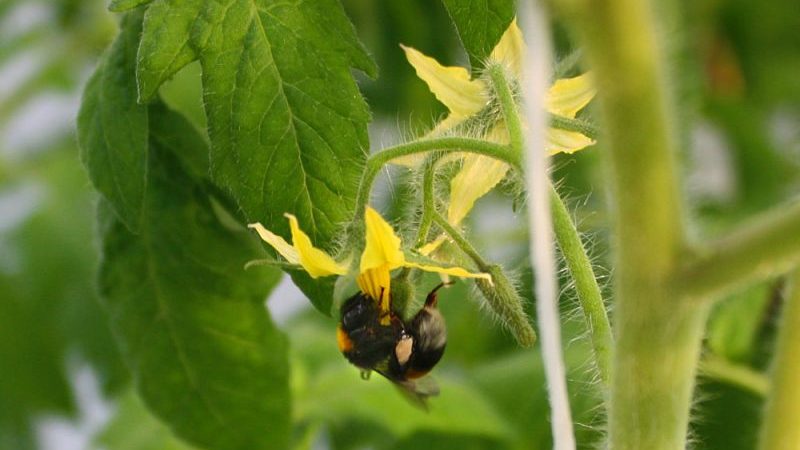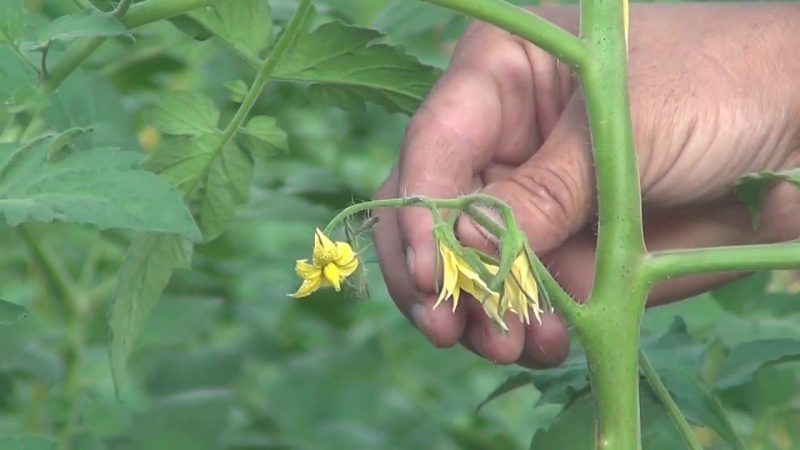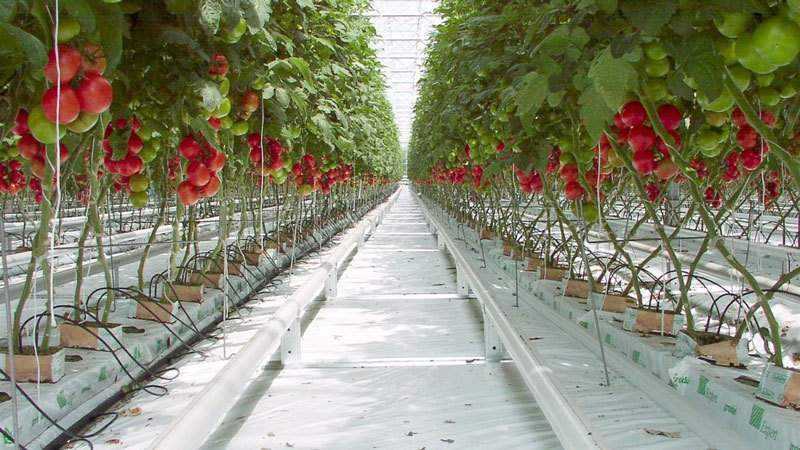Saving our tomatoes - how to pollinate tomatoes in a polycarbonate greenhouse if they are not pollinated on their own
Tomatoes are a self-pollinated crop. The fruits of these plants are set after the pistil of the flower is fertilized with its own pollen. If this process is disrupted for some reason, the tomato does not form full-fledged fruits, as a result of which hollow ovaries are formed, which the plant discards as unnecessary. To prevent such a misfortune with tomato bushes, you need to know why the fruits are not formed and be able to eliminate the causes of this phenomenon.
How to help the process of pollination of a culture, if she does not want to do it herself, and what are the secrets of obtaining abundant harvest - read on.
The content of the article
Self-pollination process
It is not without reason that full pollination of plants is considered the key to high tomato productivity. It is this stage of the growing season that is considered key, since it is pollination that leads to the formation of ovaries, from which fruits eventually grow.
How to tell if plants are pollinating themselves or if they need help? Very simple: a pollinated flower pulls its petals back. If this is not observed, the gardener is obliged to help the plant and create suitable conditions for it for normal fruiting.
Natural pollination methods
There are three ways to pollinate tomato bushes growing on a balcony, veranda or in a greenhouse:
- Attracting pollinating insects will help spraying the ovaries with a sugar solution.
- For tomatoes that grow in a greenhouse, create natural growth conditions. Insects are attracted to the pollination process. Flowers are planted for them in the greenhouse, and sweet water is placed in the aisles. Basil or marigold planted next to tomatoes will attract bees and further enhance the taste of the fruit.
- If the weather is hot and windy, the room is ventilated... The wind facilitates the natural pollination process. Open two windows on opposite walls of the building and create a draft.
On a note... Attracting bumblebees increases yields by 30-40%. It is no coincidence that these insects are used in modern industrial greenhouses.
If tomatoes are not naturally pollinated
The yield of tomatoes depends on the number of ovaries on the stalks after the flowering of the plant. Pollen forms on the bushes, which fertilizes their own and neighboring flowers. Tomatoes are pollinated by wind and insects.
Such processes in a greenhouse or loggia are also possible: just ventilate the room in warm weather, and do not close the doors at all in the heat. If this is not enough, artificial additional pollination is carried out, which will be described in detail below.
We are looking for the cause of the problem
The tomato flower has a pistil and at the same time forms its own pollen, unlike plants, which are cross-pollinated and have either stamens or pistils.
For proper fruit formation during the flowering period, a suitable indoor microclimate is required. Before pollination, you need to create the appropriate conditions, since flowering without intervention does not guarantee the formation of all ovaries.
Growers are often faced with the fact that the flowers fall or do not form ovaries at all. There are several reasons for this phenomenon:
- lack of light;
- damage to plants by infections and diseases;
- lack of nutrients;
- excess fertilizer (poultry manure, manure or nitrogen);
- the formation of a large number of barren buds;
- using your own seeds when planting tomatoes: F1 hybrids are not grown from seeds harvested in the garden.
When growing tomatoes in early spring or winter indoors, it is difficult to organize conditions for self-pollination of plants (constant ventilation and the presence of insects). In order not to put the culture at risk of infertility, vegetable growers carry out timely artificial pollination of tomatoes, having previously provided the plant with an optimal microclimate.

The process of artificial pollination of plants in the cold months
Self-pollination is carried out in several simple ways. The optimal time is morning, it is highly desirable for the weather to be sunny. The procedure is carried out during the flowering period, with an interval of two days.
Pre-use natural methods - airing the greenhouse and attracting insects (if weather conditions permit). But if such methods of pollination of plants did not bring results, the pollen is transferred by hand.
Why pollinate tomatoes in a greenhouse
A bountiful harvest of tomatoes in the future depends directly on the number of ovaries formed on the bush, which is impossible without pollination. The procedure is carried out if the plants are not pollinated on their own, for example, in cold weather, when it is impossible to organize ventilation in a visit or to use insects.
When pollination is done
When choosing the time for pollination, pay special attention to the weather conditions: on a rainy day or in high humidity, the process will be much more difficult. Pollination is carried out in the sunny time of the day, every other day. Then land immediately watered and after 3 hours open the sashes of windows and doors to ventilate the room.
Optimal humidity and temperature for indoor pollination of tomatoes
For high-quality pollination of greenhouse plants, the optimum air temperature and permissible humidity level is an important indicator, which must be controlled. In open ground, it is almost impossible to maintain suitable parameters due to unpredictable weather.
The temperature should not drop below 18 ° C heat. Otherwise, the properties of the pollen will deteriorate. Also, pollen does not scatter at a humidity of more than 70-75%. But too dry air also negatively affects the process of pollination.
Important! Do not allow the air temperature to exceed 30-40 ° C. Even during a short period of heat, flowers can fall off.
Artificial pollination methods
Pollination of tomatoes is carried out in the morning, as pollen ripens at night. This is done in the following ways:
- For artificial pollination, improvised means are used - brushes, toothbrushes or cotton balls. This method is extremely simple - brush or brush one flower at a time, then transfer the pollen to another inflorescence. When using a toothbrush, it is brought to one flower and gently moved inside the bud, then placed over the next bud and the same is done. As a result, the pollen falls inward.
- A directed air jet works well for the pollination process. To create an artificial flow of oxygen, a fan or hair dryer is used. Sometimes gardeners simply shake the bushes so that the pollen flies from one bud to another. The artificial wind should not be strong, otherwise the pollen will scatter throughout the greenhouse and fall to the ground. Place the source of airflow as far away from the flowers as possible. However, it should not be hot.
- The procedure for shaking the bushes is performed as quickly as possible. To get strong ovaries that guarantee a harvest, lightly tap the stem, shake the plant, and the pollen falls on the pistil. And if your bushes are tied up, then it is better to knock not on the stem, but on the trellis, in order to minimize contact with the plant.
Sometimes artificial pollination alone is not enough. The culture under natural growing conditions gives few ovaries, as a result, the yield decreases. Some drugs are used to stimulate the pollination process:
- «Ovary". It is a ready-made fruit formation stimulator, a universal and environmentally friendly product.
- «Bud". Accelerates fruit formation, contains sodium salt, which stimulates the development of bushes. It contains manganese, boron and copper. Soaking the seeds and treating the plants before sowing reduces the number of barren flowers and accelerates the growth of young shoots.
- «Gibberros". Culture growth regulator on a biological basis. Increases the number of ovaries, stimulates the development of tomatoes, increases the rate of ripening of the crop and gives immunity to diseases. Plants are sprayed with the product, and Gibberros is also used to soak seeds before sowing.
- «Boric acid". Dissolve 10 g of powder into a bucket of hot water. Stir the solution and cool to +25 ° C. Pour into a container and spray on the already pollinated plant.
- «Tomaton". Fruiting stimulant. It is used in greenhouses, greenhouses or outdoors under different climatic conditions. The preparation contains auxin, which promotes the entry of nutrients into the root system and reduces the growth of lateral stems. Yields increase by about 20-40%, depending on growing conditions and proper care. The crop ripens 7-12 days earlier.

Timely pollination will increase the yield and prevent fruit deformation. Performing the procedure manually requires accuracy: in tomatoes, the ovaries are fragile and tender, they break easily.
How to properly pollinate tomatoes
There will be no harvest without pollination. The greenhouse does not always meet the requirements that help the plant to pollinate and form fruit. For a culture to successfully form fruit ovaries, it needs special conditions.
Flowering and features of pollination of tomatoes
Tomatoes in the greenhouse bloom and pollinate only when the following conditions are met:
- watering the bushes is done only at the root;
- the soil is moistened infrequently, but abundantly (2 times a week, 3 liters of water per plant);
- loosening is performed at least 2 times a month;
- after each watering, the soil is mulched with peat or humus;
- air humidity not lower than 60% and not higher than 75%;
- the air temperature in the greenhouse is not lower than +18 and not higher than +30 ° С.
On a note. The optimal conditions for growing tomatoes in a greenhouse were found out in a practical way. Their organization requires effort, but they will not be in vain, but on the contrary - will lead to a bountiful harvest.
Secrets of tomato pollination
Experienced vegetable growers use a simple trick to attract pollinating insects to the greenhouse: they place a container with jam, honey or any sugar treat at the entrance. Bees come to the smell of sweets and pollinate tomatoes along the way.
On a note. Potassium fertilizers contribute to fruit setting, but without the content of potassium chloride - the plants do not tolerate chlorine. And do not forget about complex fertilizing with nitrogen-phosphorus fertilizers.
To create a humid microclimate in hot weather, the number of irrigations is increased and a container of water is placed between the rows.
To reduce moisture, mulch the soil around the tomatoes. This will prevent moisture from evaporating into the air and keep it near the roots.
Tips & Tricks
If you come to the dacha no more than 1 time a week, experienced gardeners advise you to install an automatic window in the greenhouse. The cost of it will quickly pay off with a rich harvest.
Advice! The mechanism for automatically opening and closing greenhouse windows and doors can be made by hand from 2 containers of different sizes, a plug, a connecting hose, a tube and a cord. All this can be easily found at any dacha. The containers are connected by a tube, filled with liquid and fixed in the greenhouse. One of the containers is connected to the window with a cord. The system works independently. For its functioning, only the air temperature in the greenhouse structure matters.
also in greenhouse install fans - they also stimulate pollination of plants.
According to experts, it is better to choose varieties specially bred for cultivation in greenhouses. They tolerate greenhouse conditions more easily and lend themselves well to artificial pollination.
Even if the flowers are naturally pollinated, check them. If there are non-pollinated ones, artificially fertilize them.

Conclusion
Knowing the rules of pollination of tomatoes in a greenhouse and observing the conditions necessary for a successful start of this process, vegetable growers achieve impressive results. All of the above methods are time-tested and really effective. Compared to growing tomatoes in the open field, the greenhouse yield is several times higher in quantity.
How to pollinate tomatoes in a polycarbonate greenhouse, you will learn by watching the following video: